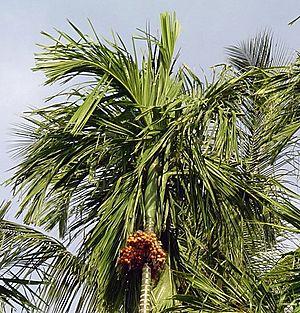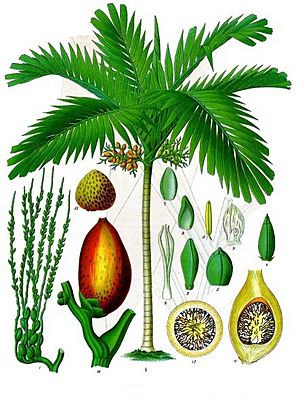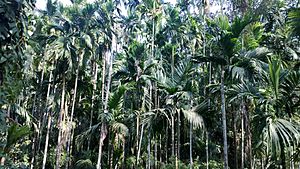Areca catechu facts for kids
Quick facts for kids Areca catechu |
|
|---|---|
 |
|
| Fruiting specimen | |
| Scientific classification | |
| Genus: |
Areca
|
| Species: |
catechu
|
| Synonyms | |
|
|
The Areca palm (scientific name: Areca catechu) is a type of palm. It grows in many warm, tropical places around the world. You can find it in the Pacific Ocean islands, Asia, and parts of East Africa.
Scientists think this palm first came from the Philippines. But now, people grow it in many countries. It is common in southern China, Taiwan, India, Bangladesh, the Maldives, Sri Lanka, Cambodia, Laos, Thailand, Vietnam, Malaysia, Indonesia, New Guinea, and many Pacific islands. It also grows in the West Indies.
People call this palm by many names in English. Some names are areca palm, betel palm, or Indian nut. It is often called the betel tree because its fruit, the areca nut, is often chewed with the betel leaf. The betel leaf comes from a different plant.
Contents
About the Areca Palm
How it Grows
The Areca palm is a medium-sized tree. It grows straight up to about 20 meters (65 feet) tall. Its trunk is usually 10 to 15 centimeters (4 to 6 inches) wide. The leaves are long, about 1.5 to 2 meters (5 to 6.5 feet). They have many small leaflets packed closely together.
What it is Used For
The Areca catechu is grown for its important fruit, the areca nut. This nut is very popular for chewing in many Asian countries. These include China, Bangladesh, Taiwan, Vietnam, the Philippines, Malaysia, Maldives, Myanmar, and India. It is also very popular in the Pacific Islands, especially Papua New Guinea. Many working people in Taiwan enjoy chewing areca nut.
The Areca palm is also used to decorate large indoor spaces. You might see it in malls or hotels. When grown indoors, it does not produce fruit or reach its full size. It grows slowly and needs a lot of light but not much water.
In India, people collect the dry, fallen leaves of the palm. They use heat and pressure to make them into disposable plates and bowls. These are used for eating.
Areca Palm and People
Place Names
The areca nut is very important in the culture of Austronesian people. This is especially true in modern-day Indonesia and Malaysia. Many cities and areas in these countries are named after the areca nut. For example, the cities of Tanjung Pinang and Pangkal Pinang in Indonesia. Also, the Indonesian province of Jambi and Penang Island in Malaysia. Other places named after the areca nut include Fua Mulaku in the Maldives, Guwahati in India, and coastal areas of Kerala and Karnataka in India.
Gallery
See also
 In Spanish: Areca catechu para niños
In Spanish: Areca catechu para niños


















